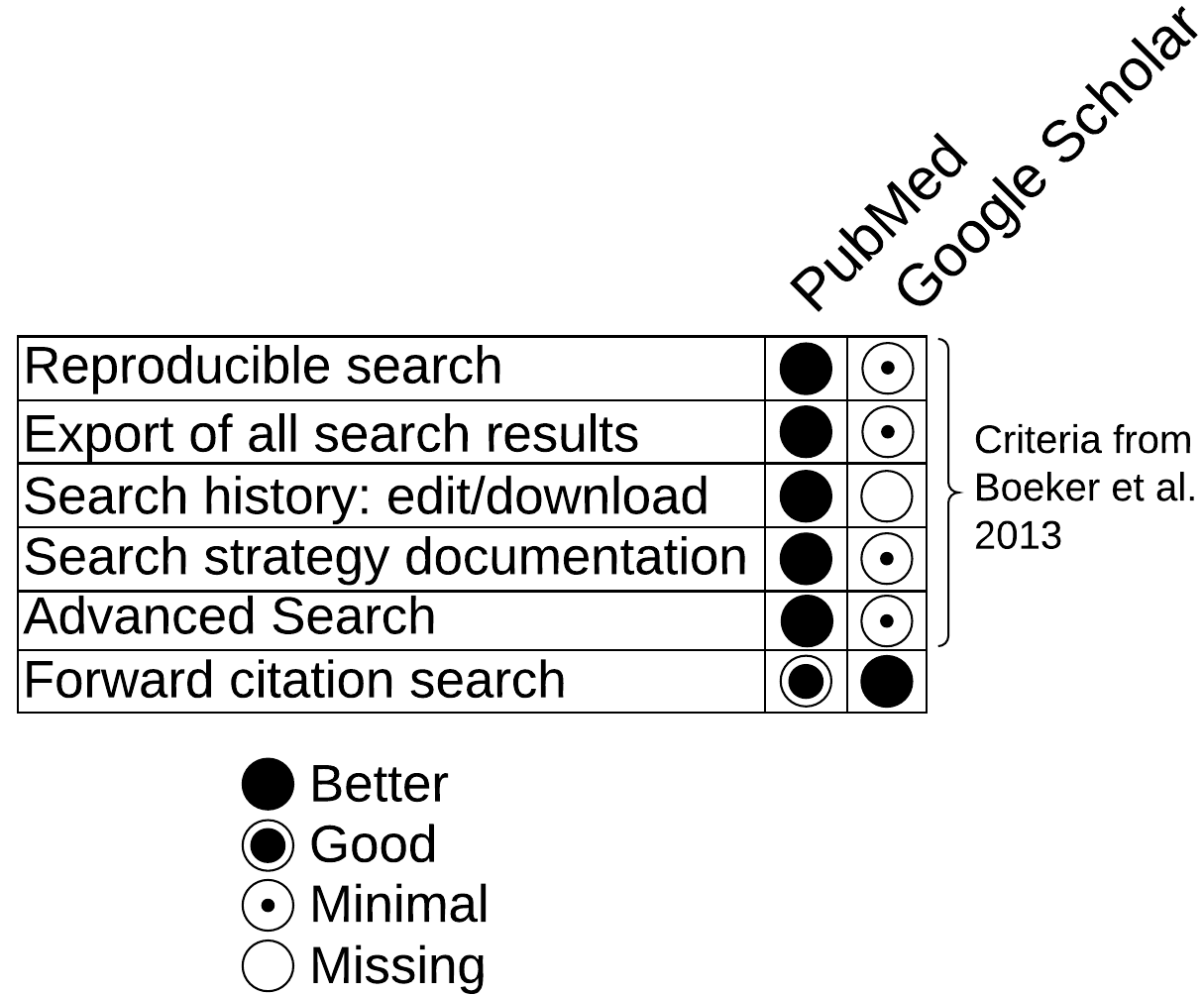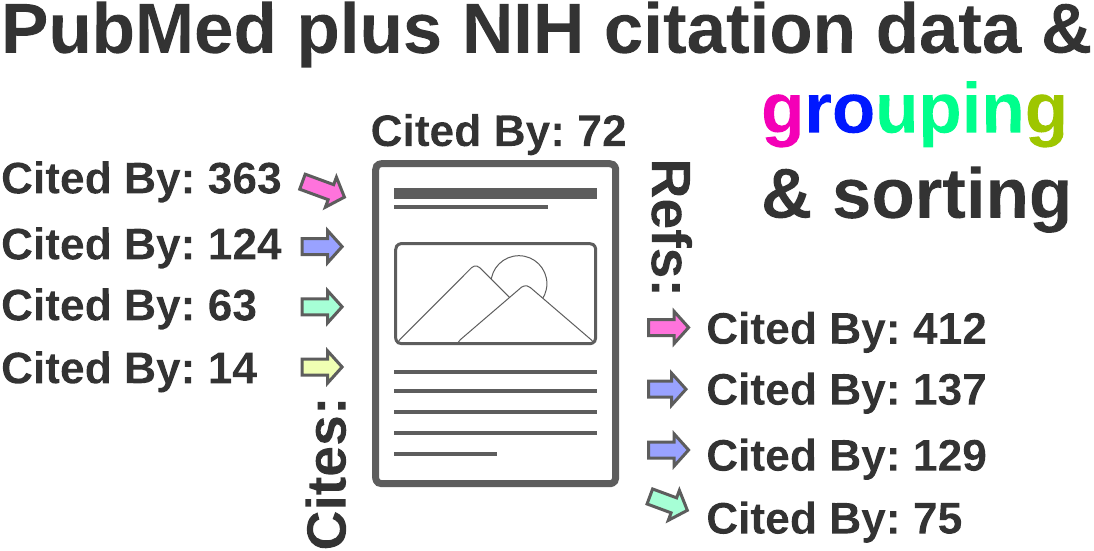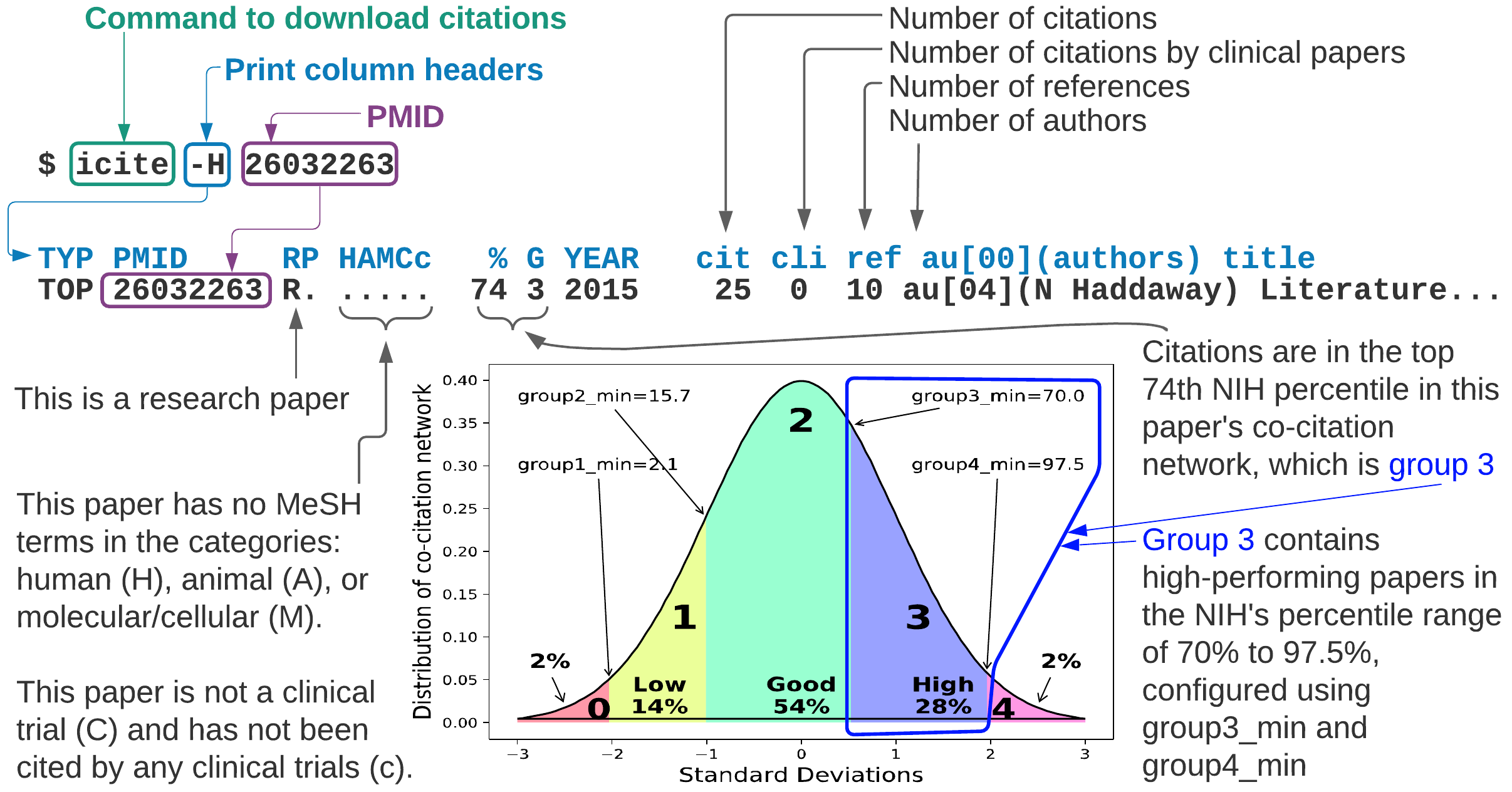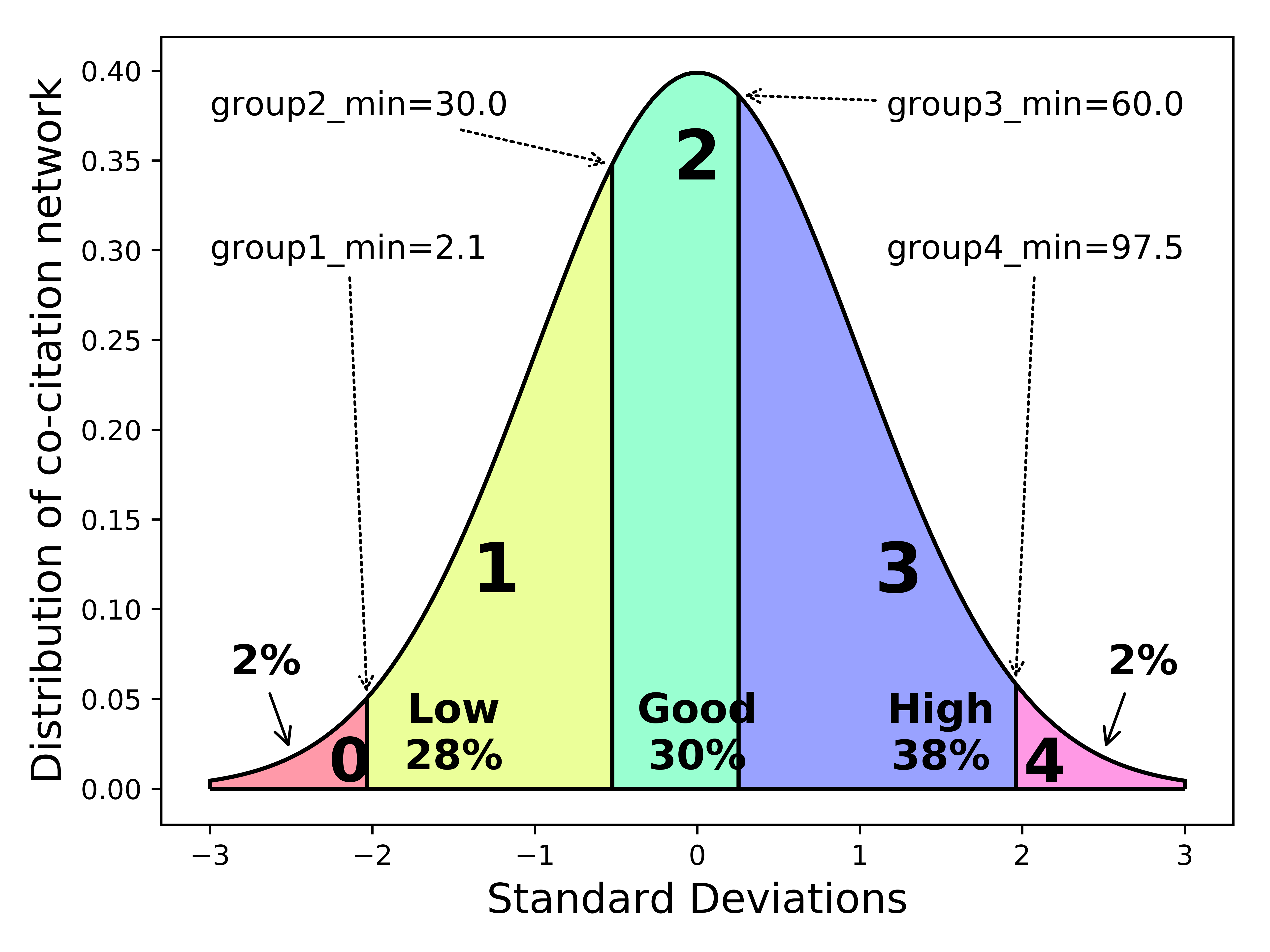Augment's a PubMed literature search with citation data from NIH-OCC's iCite.
Project description
PubMed ID (PMID) Cite
Turbocharge a PubMed literature search in biomedicine, biochemistry, chemistry, behavioral science, and other life sciences by linking citation data from the National Institutes of Health (NIH) with PubMed IDs (PMIDs) using the command line rather than clicking and clicking and clicking on Google Scholar "Cited by N" links.
This open-source project is part of a peer-reviewed paper published in Research Synthesis Methods. Please cite if you use pmidcite in your research or literature search.
Contact: dvklopfenstein@protonmail.com
Usage
- 1) Download citation counts and data for a research paper
- 2) Forward citation search: following a paper's Cited by links or Forward snowballing
- 3) Backward citation search: following the links to a paper's references or Backward snowballing
1) Download citation counts and data for a research paper
$ icite -H 26032263
- This paper (PMID 26032263) has
25citations,10references, and4authors. - This paper is performing well (
74th percentile in column%) compared to its peers.
NIH percentile
This paper is performing well (74th percentile) compared to its peers (column %).
The NIH percentile grouping (column G) helps to
highlight the better performing papers in groups 2, 3, and 4 by
sorting the citing papers by group first, then publication year.
The sort places the lower performing papers in groups 0 or 1 at the back.
New papers appear at the beginning of a sorted list, no matter how many citations they have to better facilitate researchers in finding the latest discoveries.
The grouping of papers by NIH percentile grouping is a novel feature created by dvklopfenstein for this project.
2) Forward citation search
Also known as following a paper's Cited by links or Forward snowballing
icite -H; icite 26032263 --load_citations | sort -k6 -r
or
icite -H; icite 26032263 -c | sort -k6 -r
3) Backward citation search
Also known as following links to a paper's references or Backward snowballing
$ icite -H; icite 26032263 --load_references | sort -k6 -r
or
$ icite -H; icite 26032263 -r | sort -k6 -r
PubMed vs Google Scholar

In 2013, Boeker et al. recommended that a scientific search interface contain five integrated search criteria. PubMed implements all five, while Google did not in 2013 or today.
Google's highly popular implementation of the forward citation search through their ubiquitous "Cited by N" links is a "Better" experience than the PubMed's "forward citation search" implementation.
But if your research is in the health sciences and you are amenable to working from the command line, you can use PubMed in your browser plus citation data downloaded from the NIH using the command-line using pmidcite. The NIH's citation data includes a paper's ranking among its co-citation network.
What is in PubMed? Take a quick tour

PubMed is a search interface and toolset used to access over 30.5 million article records from databases such as:
- MEDLINE: a highly selective database started in the 1960s
- PubMed Central (PMC): an open-access database for full-text papers that are free of cost
- Additional content such as books and articles published before the 1960s
Usage details
Download citations for all papers returned from a PubMed search
Make a copy of src/bin/dnld_pmids.py and add your PubMed search to the end of the queries list.
There are two PubMed searches in this example:
systematic review AND "how to"[TI]Orcinus Orca Type D
The PubMed search results are saved to specified filenames such as systematic_review.txt to be grepped and sorted.
def main():
"""Download PMIDs returned for a PubMed query. Write an iCite report for each PMID"""
queries = [
# Output filenames PubMed query
# ----------------- -----------------------------------
('systematic_review.txt', 'systematic review AND "how to"[TI]'),
('rarely_seen_killer_whale.txt', 'Orcinus Orca Type D'),
]
obj = PubMedQueryToICite(force_dnld=True)
dnld_idx = obj.get_index(sys.argv)
obj.run(queries, dnld_idx)
To have better access to PubMed search results,
get a NCBI API key using these instuctions:
https://ncbiinsights.ncbi.nlm.nih.gov/2017/11/02/new-api-keys-for-the-e-utilities
Table of Contents
- pmidcite, on the command line:
- pmidcite, the Python library
- pmidcite:
- Referenced
Command Line Interface (CLI)
A Command-Line Interface (CLI) can be preferable to a Graphical User Interface (GUI) because:
- processing can be automated from a script
- time-consuming mouse clicking is reduced
- more data can be seen at once on a text screen than in a browser, giving the researcher a better overall impression of the full set of information [1]
Researchers who use Linux or Mac already work from the command line. Researchers who use Windows can get that Linux-like command line feeling while still running native Windows programs by downloading Cygwin from https://www.cygwin.com/ [1].
1) Get citation counts, given PMIDs
Quickly get the number of citations for a research paper with PMID, 26032263:
$ icite 26032263 -H
TYP PMID RP HAMCc % G YEAR cit cli ref au[00](authors) title
TOP 26032263 R. ..... 68 2 2015 16 0 10 au[04](N R Haddaway) Making literature reviews more reliable through application of lessons from systematic reviews.
- The first line (
TYP PMID ...) contains the column headers (-H). - The second line (
TOP ...) is the citation data from NIH's iCite database. - The citation count,
16, is under thecitcolumn header.
The group number, 2 (SD column) indicates that the paper has a good citation rate,
specifically it is in the 68th percentile (% column) compared to its peers.
Column header key (-k)
$ icite -k
KEYS TO PAPER LINE:
TYP PubMedID RP HAMCc % G YEAR x y z au[A](First Author) Title of paper
TYPe of relationship to the researcher-requested paper (TYP):
TOP: The paper requested by the researcher
CIT: A paper that cited TOP
CLI: A clinical paper that cited TOP
REF: A paper referenced in the TOP paper's bibliography
NIH iCite details:
PubMedID: PubMed ID (PMID)
RP section:
----------------------------------
R: Is a research article
P: iCite has calculated an initial Relative Citation Ratio (RCR) for new papers
HAMCc section:
----------------------------------
H: Has MeSH terms in the human category
A: Has MeSH terms in the animal category
M: Has MeSH terms in the molecular/cellular biology category
C: Is a clinical trial, study, or guideline
c: Is cited by a clinical trial, study, or guideline
NIH section, based on Relative Citation Ratio (RCR):
----------------------------------
%: NIH citation percentile rounded to an integer. -1 means "not determined" or TBD
G: NIH citation percentile group: 0=-3SD 1=-2SD 2=+/-1SD 3=+2SD 4=+3SD or i=TBD
YEAR/citations/references section:
----------------------------------
YEAR: The year the article was published
x: Total of all unique articles that have cited the paper, including clinical articles
y: Number of unique clinical articles that have cited the paper
z: Number of references
au[A]: A is the number of authors
Citation group numbers [1]
The pmidcite citation rate group numbers, 0, 1, 2, 3, and 4 (SD column),
are determined using the NIH Relative Citation Rate (RCR) [5] percentile.
If the NIH has not yet determined a citation rate for new papers,
the pmidcite group number is i.
2) Sort citation counts, given PMIDs
Sort the citations (CIT) of the paper with PMID 26032263 first by citation group (2 and i), then by year.
The citation group shown contains:
iNew paper and not yet rated. Theivariable will be set at a later date by the NIH2These papers are performing well
Sort options:
-k6: sort starting with the 6th column containing citation group, then by all text to the right.-r: reverse the sort so the newest papers are at the top
$ icite 26032263 -v | grep CIT | sort -k6 -r
CIT 32557171 .. H.... -1 i 2020 0 0 21 au[05](Jillian Knox) Usage, definition, and measurement of coexistence, tolerance and acceptance in wildlife conservation research in Africa.
CIT 32317639 R. HA... -1 i 2020 0 0 8 au[09](Trevor J Krabbenhoft) FiCli, the Fish and Climate Change Database, informs climate adaptation and management for freshwater fishes.
CIT 30285277 R. ..... -1 i 2019 2 0 14 au[02](Neal R Haddaway) Predicting the time needed for environmental systematic reviews and systematic maps.
CIT 30055022 .. HA... -1 i 2019 1 0 12 au[04](Hillary Smith) Hunting for common ground between wildlife governance and commons scholarship.
CIT 31598307 R. HA... -1 i 2019 1 0 12 au[02](Igor Khorozyan) How long do anti-predator interventions remain effective? Patterns, thresholds and uncertainty.
CIT 31024221 R. ..... -1 i 2019 0 0 7 au[02](Micah G Bennett) MEASURING LOTIC ECOSYSTEM RESPONSES TO NUTRIENTS: A Mismatch that Limits the Synthesis and Application of Experimental Studies to Management.
CIT 29488217 .P .A... 76 2 2018 7 0 64 au[03](Nicole V Coggan) A global database and 'state of the field' review of research into ecosystem engineering by land animals.
CIT 29514874 .P .A... 47 2 2018 3 0 38 au[02](Kelly D Hannan) Aquatic acidification: a mechanism underpinning maintained oxygen transport and performance in fish experiencing elevated carbon dioxide conditions.
CIT 28642071 .. H.... 75 2 2017 11 0 80 au[05](Ora Oudgenoeg-Paz) The link between motor and cognitive development in children born preterm and/or with low birth weight: A review of current evidence.
CIT 28061344 R. ..... 70 2 2017 8 0 54 au[03](Maria Cristina Mangano) Monitoring of persistent organic pollutants in the polar regions: knowledge gaps & gluts through evidence mapping.
CIT 28042667 R. H.... 53 2 2017 8 0 20 au[02](Martin J Westgate) The difficulties of systematic reviews.
CIT 29451529 .. H.... 56 2 2016 9 0 20 au[01](Jennifer A Byrne) Improving the peer review of narrative literature reviews.
CIT 26984257 R. ..... 46 2 2016 9 0 9 au[04](Neal R Haddaway) The benefits of systematic mapping to evidence-based environmental management.
CIT 27617203 .. ..... 43 2 2016 5 0 40 au[02](Neal R Haddaway) On the benefits of systematic reviews for wildlife parasitology.
Other sort examples
In 2018 Fiorini et al. [7], the creaters of PubMed's "best match" relevance sort ordering in PubMed, found that the most important document features to feed into the PubMed sorting algorithm are publication year and past usage.
Mimic this by using the -k6 argument to sort the citation group (usage group), which does two things:
- First, it highlights the newest or best performing papers by putting them at the beginning, while getting the lowest performing papers out of the mix by placing them at the end.
- Second, it shows the newest papers first in each usage group, highlighting them profoundly.
We chose to highlight using usage group first, rather than NIH RCR percentile in the 5th column, seen with values -1, 76, etc. because
only seeing the best performing papers first might bias the paper chosen for further examination
to only the best performing papers regardless of publication year.
3) Query PubMed and download the citation data
Query PubMed and download the citation data from the script, src/bin/dnld_pmids.py.
NOTE: Copy dnld_pmids.py to your project repo. Don't modify the pmidcite repo.
1. Add your query to your dnld_pmids.py script
queries = [
# Output filename PubMed query
# ----------------- -----------------------------------
('killer_whale.txt', 'Orcinus Orca Type D'),
]
2. Run the script
$ src/bin/dnld_pmids.py
3 IDs FOR pubmed QUERY(Orcinus Orca Type D)
3 WROTE: ./log/pmids/killer_whale.txt
3 WROTE: ./log/icite/killer_whale.txt
3. Examine the citation and pubmed data, sorting by year (column 7; -k7)
$ grep TOP ./log/icite/Orcinus_Orca_Type_D.txt | sort -k7
TOP 20050301 R. .A... 70 2 2009 43 0 25 au[05](Andrew D Foote) Ecological, morphological and genetic divergence of sympatric North Atlantic killer whale populations.
TOP 22882545 .. .A... 63 2 2013 25 0 24 au[03](P J N de Bruyn) Killer whale ecotypes: is there a global model?
TOP 31461780 R. .A... -1 i 2020 0 0 0 au[06](Robert L Pitman) Enigmatic megafauna: type D killer whale in the Southern Ocean.
4) Get citation data using PMIDs downloaded from PubMed
Note that the PubMed query using NIH E-Utils from the dnld_pmids.py script
will often be slightly different than the query run on the PubMed website.
PubMed has been alerted.
Consequently, you may also want to view citation data on PMID PubMed query results
downloaded from the PubMed website into a file such as pmid-OrcinusOrc-set.txt:
Save->All results, Format=PMID
$ icite -i pmid-OrcinusOrc-set.txt
TOP 30123694 RP HA... 17 2 2018 1 0 6 au[07](Paul Tixier) Killer whale (<i>Orcinus orca</i>) interactions with blue-eye trevalla (<i>Hyperoglyphe antarctica</i>) longline fisheries.
TOP 31461780 R. .A... -1 i 2020 0 0 0 au[06](Robert L Pitman) Enigmatic megafauna: type D killer whale in the Southern Ocean.
TOP 22882545 .. .A... 63 2 2013 25 0 24 au[03](P J N de Bruyn) Killer whale ecotypes: is there a global model?
TOP 20050301 R. .A... 70 2 2009 43 0 25 au[05](Andrew D Foote) Ecological, morphological and genetic divergence of sympatric North Atlantic killer whale populations.
5) Create ASCII plots
Create a scatter plot of publication year vs. citation count for a list of papers. This will be made friendlier.
Columns 7 and 8 contain the year and the citation count.
$ grep TOP log/icite/Osbourn_Anne.txt | awk '{print $7 " " $8}' | scatter.py
-------------------------------------------------------------------------------------------- 282
| 1 |
| |
| |
| |
| |
| |
| |
| |
| 1 |
| |
| 1 |
| |
| |
| 1 |
| 1 1 |
|1 1 |
| |
| 1 |
| 1 1 |
| 1 1 |
| 1 1 1 |
| 1 1 1 |
| 1 1 1 1 |
| 1 1 1 |
| 1 1 1 1 2 2 |
| 1 1 2 |
| 1 2 1 1 1 |
|1 1 1 2 1 1 3 1 4 |
| 1 1 1 1 1 3 1 1 1 5 |
| 2 2 1 1 2 1 7 3|
-------------------------------------------------------------------------------------------- 0
2002 2020
Installation
To install from PyPI
pip install pmidcite
Setup
Save your literature search in a GitHub repo.
1. Add a pmidcite init file
Add a .pmidciterc init file to a non-git managed directory, such as home (~)
$ icite --generate-rcfile | tee ~/.pmidciterc
[pmidcite]
email = name@email.edu
apikey = long_hex_digit
tool = scripts
dir_icite_py = .
dir_pubmed_txt = .
dir_pmids = .
dir_icite = .
$ export PMIDCITECONF=~/.pmidciterc
Do not version manage the .pmidciterc using a tool such as GitHub because it
contains your personal email and your private NCBI API key.
2. Add directories
Add directories which match those in ~/.pmidciterc:
$ mkdir [GIT_REPO_PATH]/icite
$ mkdir [GIT_REPO_PATH]/log
$ mkdir [GIT_REPO_PATH]/log/pubmed
$ mkdir [GIT_REPO_PATH]/log/pmids
$ mkdir [GIT_REPO_PATH]/log/icite
3. NCBI E-Utils API key
To download PubMed abstracts and PubMed search results using NCBI's E-Utils,
get an NCBI API key using these instructions:
https://ncbiinsights.ncbi.nlm.nih.gov/2017/11/02/new-api-keys-for-the-e-utilities
Set the apikey value in the config file: ~/.pmidciterc
Contact
email: dvklopfenstein@protonmail.com
https://orcid.org/0000-0003-0161-7603
How to Cite
If you use pmidcite in your research or literature search, please cite paper 1 (pmidcite) and paper 3 (NIH citation data).
Please also consider reading and citing Gusenbauer's response (paper 2) about improving search for all during the information avalanche of these times:
-
Commentary to Gusenbauer and Haddaway 2020: Evaluating Retrieval Qualities of PubMed and Google Scholar
Klopfenstein DV and Dampier W
2020 | Research Synthesis Methods | PMID: 33031632 | DOI: 10.1002/jrsm.1456 | pdf -
Gusenbauer's response:
What every Researcher should know about Searching – Clarified Concepts, Search Advice, and an Agenda to improve Finding in Academia
Gusenbauer M and Haddaway N
2020 | Research Synthesis Methods | PMID: 33031639 | DOI: 10.1002/jrsm.1457 | pdf -
The NIH citation data used by pmidcite -- Scientific Influence, Translation, and Citation counts:
The NIH Open Citation Collection: A public access, broad coverage resource
Hutchins BI ... Santangelo GM
2019 | PLoS Biology | PMID: 31600197 | DOI: 10.1371/journal.pbio.3000385
References
Please consider reading and citing the paper [4] which inspired the creation of pmidcite [1] and the authors' response to our paper [2]:
- Which Academic Search Systems are Suitable for Systematic Reviews or Meta-Analyses? Evaluating Retrieval Qualities of Google Scholar, PubMed and 26 other Resources
Gusenbauer M and Haddaway N
2019 | Research Synthesis Methods | PMID: 31614060 | DOI: 10.1002/jrsm.1378
Mentioned in this README are also these outstanding contributions:
-
Relative Citation Ratio (RCR): A New Metric That Uses Citation Rates to Measure Influence at the Article Level
Hutchins BI, Xin Yuan, Anderson JM, and Santangelo, George M.
2016 | PLoS Biology | PMID: 27599104 | DOI: 10.1371/journal.pbio.1002541 -
Google Scholar as replacement for systematic literature searches: good relative recall and precision are not enough
Boeker M et al.
2013 | BMC Medical Research Methodology | PMID: 24160679 | DOI: 10.1186/1471-2288-13-131 -
Best Match: New relevance search for PubMed
Fiorini N ... Lu Zhiyong
2018 | PLoS Biology | PMID: 30153250 | DOI: 10.1371/journal.pbio.2005343
PDFs
- PMIDCITE Manuscript with the original text box formatting
- Supplemental Material
- Gusenbauer's Response
Contact
dvklopfenstein@protonmail.com
https://orcid.org/0000-0003-0161-7603
Copyright (C) 2019-present pmidcite, DV Klopfenstein. All rights reserved.
Project details
Release history Release notifications | RSS feed
Download files
Download the file for your platform. If you're not sure which to choose, learn more about installing packages.



















